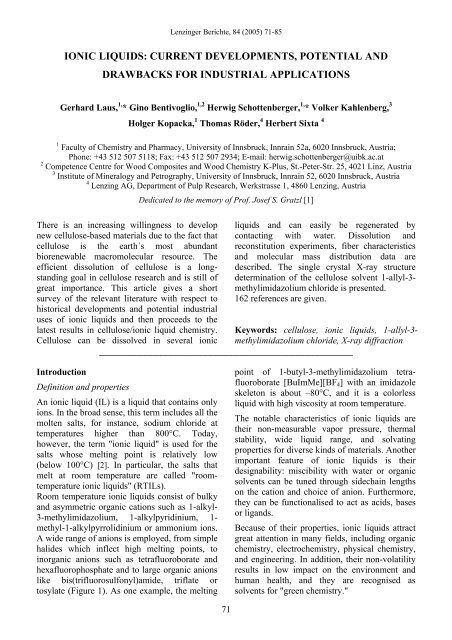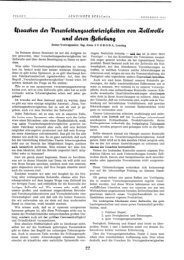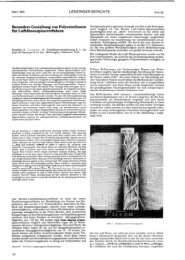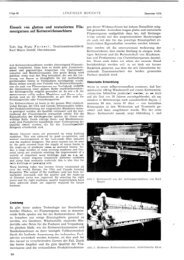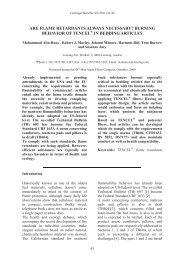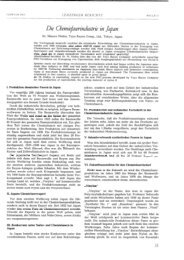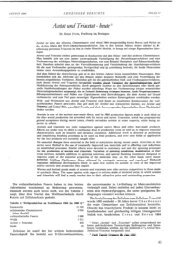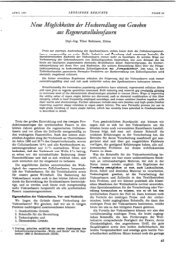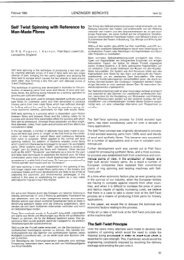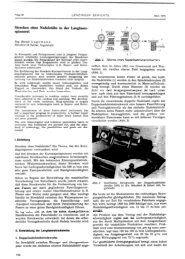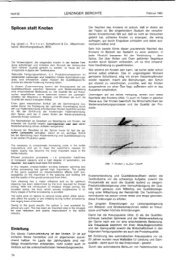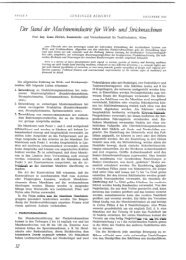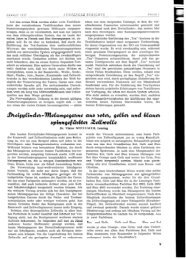Ionic liquid: current developments, potential and ... - Lenzing
Ionic liquid: current developments, potential and ... - Lenzing
Ionic liquid: current developments, potential and ... - Lenzing
You also want an ePaper? Increase the reach of your titles
YUMPU automatically turns print PDFs into web optimized ePapers that Google loves.
<strong>Lenzing</strong>er Berichte, 84 (2005) 71-85<br />
IONIC LIQUIDS: CURRENT DEVELOPMENTS, POTENTIAL AND<br />
DRAWBACKS FOR INDUSTRIAL APPLICATIONS<br />
Gerhard Laus, 1, * Gino Bentivoglio, 1,2 Herwig Schottenberger, 1, * Volker Kahlenberg, 3<br />
Holger Kopacka, 1 Thomas Röder, 4 Herbert Sixta 4<br />
1 Faculty of Chemistry <strong>and</strong> Pharmacy, University of Innsbruck, Innrain 52a, 6020 Innsbruck, Austria;<br />
Phone: +43 512 507 5118; Fax: +43 512 507 2934; E-mail: herwig.schottenberger@uibk.ac.at<br />
2 Competence Centre for Wood Composites <strong>and</strong> Wood Chemistry K-Plus, St.-Peter-Str. 25, 4021 Linz, Austria<br />
3 Institute of Mineralogy <strong>and</strong> Petrography, University of Innsbruck, Innrain 52, 6020 Innsbruck, Austria<br />
4 <strong>Lenzing</strong> AG, Department of Pulp Research, Werkstrasse 1, 4860 <strong>Lenzing</strong>, Austria<br />
There is an increasing willingness to develop<br />
new cellulose-based materials due to the fact that<br />
cellulose is the earth´s most abundant<br />
biorenewable macromolecular resource. The<br />
efficient dissolution of cellulose is a longst<strong>and</strong>ing<br />
goal in cellulose research <strong>and</strong> is still of<br />
great importance. This article gives a short<br />
survey of the relevant literature with respect to<br />
historical <strong>developments</strong> <strong>and</strong> <strong>potential</strong> industrial<br />
uses of ionic <strong>liquid</strong>s <strong>and</strong> then proceeds to the<br />
latest results in cellulose/ionic <strong>liquid</strong> chemistry.<br />
Cellulose can be dissolved in several ionic<br />
Dedicated to the memory of Prof. Josef S. Gratzl [1]<br />
71<br />
<strong>liquid</strong>s <strong>and</strong> can easily be regenerated by<br />
contacting with water. Dissolution <strong>and</strong><br />
reconstitution experiments, fiber characteristics<br />
<strong>and</strong> molecular mass distribution data are<br />
described. The single crystal X-ray structure<br />
determination of the cellulose solvent 1-allyl-3methylimidazolium<br />
chloride is presented.<br />
162 references are given.<br />
Keywords: cellulose, ionic <strong>liquid</strong>s, 1-allyl-3methylimidazolium<br />
chloride, X-ray diffraction<br />
__________________________________________________<br />
Introduction<br />
Definition <strong>and</strong> properties<br />
An ionic <strong>liquid</strong> (IL) is a <strong>liquid</strong> that contains only<br />
ions. In the broad sense, this term includes all the<br />
molten salts, for instance, sodium chloride at<br />
temperatures higher than 800°C. Today,<br />
however, the term "ionic <strong>liquid</strong>" is used for the<br />
salts whose melting point is relatively low<br />
(below 100°C) [2]. In particular, the salts that<br />
melt at room temperature are called "roomtemperature<br />
ionic <strong>liquid</strong>s" (RTILs).<br />
Room temperature ionic <strong>liquid</strong>s consist of bulky<br />
<strong>and</strong> asymmetric organic cations such as 1-alkyl-<br />
3-methylimidazolium, 1-alkylpyridinium, 1methyl-1-alkylpyrrolidinium<br />
or ammonium ions.<br />
A wide range of anions is employed, from simple<br />
halides which inflect high melting points, to<br />
inorganic anions such as tetrafluoroborate <strong>and</strong><br />
hexafluorophosphate <strong>and</strong> to large organic anions<br />
like bis(trifluorosulfonyl)amide, triflate or<br />
tosylate (Figure 1). As one example, the melting<br />
point of 1-butyl-3-methylimidazolium tetrafluoroborate<br />
[BuImMe][BF4] with an imidazole<br />
skeleton is about –80°C, <strong>and</strong> it is a colorless<br />
<strong>liquid</strong> with high viscosity at room temperature.<br />
The notable characteristics of ionic <strong>liquid</strong>s are<br />
their non-measurable vapor pressure, thermal<br />
stability, wide <strong>liquid</strong> range, <strong>and</strong> solvating<br />
properties for diverse kinds of materials. Another<br />
important feature of ionic <strong>liquid</strong>s is their<br />
designability: miscibility with water or organic<br />
solvents can be tuned through sidechain lengths<br />
on the cation <strong>and</strong> choice of anion. Furthermore,<br />
they can be functionalised to act as acids, bases<br />
or lig<strong>and</strong>s.<br />
Because of their properties, ionic <strong>liquid</strong>s attract<br />
great attention in many fields, including organic<br />
chemistry, electrochemistry, physical chemistry,<br />
<strong>and</strong> engineering. In addition, their non-volatility<br />
results in low impact on the environment <strong>and</strong><br />
human health, <strong>and</strong> they are recognised as<br />
solvents for "green chemistry."
However, it remains to be seen how<br />
"environmentally-friendly" ILs will be once<br />
widely used by industry. Research into IL<br />
aquatic toxicity has shown them to be as toxic or<br />
more so than many <strong>current</strong> solvents already in<br />
use. Balancing between zero Volatile Organic<br />
Compounds (VOC) emissions, <strong>and</strong> avoiding<br />
spills into waterways (via waste ponds/streams,<br />
etc.) should become a top priority. That said,<br />
with the enormous diversity of substituents<br />
available to make useful ILs, they ought to be<br />
designed with the foresight of having useful<br />
physical properties <strong>and</strong> less toxic chemical<br />
properties [3].<br />
Figure 1. The cation (usually organic) <strong>and</strong> the anion<br />
(usually inorganic) present in ILs [4] are designed so that<br />
the resulting salts cannot pack compactly. As a result, ILs<br />
do not easily crystallise <strong>and</strong> remain <strong>liquid</strong> through a wide<br />
range of temperatures [5].<br />
<strong>Lenzing</strong>er Berichte, 84 (2005) 71-85<br />
72<br />
Synthetic concepts for ILs<br />
Principal synthetic concepts for ILs [6] involve<br />
quaternisation reactions to generate the cation<br />
followed by anion (often halide) metathesis,<br />
either by (a) addition of metal salts to precipitate<br />
the undesired anion, possibly use of silver salts,<br />
(b) addition of strong Brönsted acids to release<br />
the unwanted anion as the volatile corresponding<br />
acid, (c) use of ion exchange resins, or (d)<br />
treatment with Lewis acids to form complex<br />
anions such as chloroaluminates. Efficient<br />
synthetic procedures for imidazolium salts were<br />
described [7, 8]. Often traces of the halide ions<br />
or acids remain in the product, either giving rise<br />
to <strong>liquid</strong> eutectic mixtures of otherwise solid<br />
salts or leading to unwanted chemical reactivity.<br />
Halide-free ILs can be produced by using<br />
alkylcarbonates as alkylating reagents <strong>and</strong><br />
removing the carbonate as gaseous CO2 or<br />
unsoluble metal salt [9, 10].<br />
History<br />
The original family of great-gr<strong>and</strong>father ILs, Nalkylpicolinium<br />
halides, was described in 1899<br />
[11] with melting points which classify them as<br />
RTILs. Even earlier (1876), some members of<br />
this class of salts have been prepared as sirupy<br />
<strong>liquid</strong>s by the later Nobel laureate Ramsay [12].<br />
Other great-gr<strong>and</strong>father ILs, quaternary<br />
anilinium salts, were reported at the beginning of<br />
the twentieth century [13, 14, 15, 16, 17, 18].<br />
Generally, these early reports are overlooked or<br />
ignored. Alkylammonium nitrates were<br />
described in 1914 [19]. Several water-unstable<br />
chloroaluminates <strong>and</strong> chloroferrates were<br />
discovered in the following years. The<br />
systematic utilisation of RTILs was reported by<br />
Hurley <strong>and</strong> Wier in 1951 [20]. In their work,<br />
electrodeposition of metals from fused mixtures<br />
of ethylpyridinium bromide <strong>and</strong> metal chlorides<br />
was studied. The next decades saw the discovery<br />
of low-melting N-ethyl-2-ethoxypyridinium<br />
tetrafluoroborate [21] <strong>and</strong> the development of<br />
guanidinium chlorides [22] <strong>and</strong> quaternary<br />
imidazolium salts [23, 24, 25, 26], which may be<br />
called "gr<strong>and</strong>father ILs" from today´s point of<br />
view. The list of ILs grows daily. Most recently,<br />
the 1st International Congress on <strong>Ionic</strong> Liquids<br />
(COIL), held in June 2005 in Salzburg (the City<br />
of Salt), Austria, attracted more than 400<br />
participants from 33 countries (Figure 2).
Figure 2. Some of the authors among other participants of<br />
the COIL 2005 meeting in Salzburg, Austria.<br />
New <strong>developments</strong><br />
In recent years, new guanidinium-based <strong>liquid</strong><br />
salts [27], countless imidazolium salts, even<br />
imidazolium melts with carborane [28] <strong>and</strong><br />
stannaborane anions [29], pyridinium, <strong>and</strong><br />
pyrrolidinium salts, or eutectic mixtures [30, 31,<br />
32] were reported. New tetraalkylphosphoniumbased<br />
ILs with rather high viscosities showed<br />
nonlinear optical behaviour [33]. Fluorinecontaining<br />
cations [34], such as polyfluoroalkyl-<br />
1,2,4-triazolium salts [35] possess excellent<br />
properties with respect to air-, water-, <strong>and</strong> thermal<br />
stability. Low viscosity ILs, the hydrophilic<br />
dicyanamides [36] <strong>and</strong> the hydrophobic<br />
perfluoroalkyltrifluoroborate [10, 37, 38] were<br />
investigated. Low-coordinating <strong>and</strong> non-fluorine<br />
containing anions such as bis(oxalato)boranates<br />
(BOB) were studied [39]. Properties of<br />
imidazolium salts depend on the nature of the<br />
anions [40, 41] as well as on the alkyl chain<br />
length of 1,3-dialkylimidazolium cations [42,<br />
43]. The physico-chemical properties <strong>and</strong><br />
reactivities of ILs were reviewed [44, 45]. For<br />
analytical applications [46, 47, 48, 49] the nature<br />
of both cation <strong>and</strong> anion is essential. Flammability<br />
<strong>and</strong> thermal stability of trialkylimidazolium<br />
salts were found to be more dependent<br />
upon the anion than the cation [50]. Recently,<br />
energetic ionic <strong>liquid</strong>s such as azido derivatives<br />
of 1,2,4-triazolium salts, notably nitrate <strong>and</strong><br />
perchlorate [51], <strong>and</strong> other energetic azolium<br />
salts with low melting points were described [27,<br />
52, 53, 54]. However, it should be cautioned that<br />
reported melting points (Figure 3) are often<br />
unreliable due to the hygroscopicity of these<br />
materials <strong>and</strong> the existence of polymorphs [47,<br />
55]. Finally, the vapour pressure of [BuImMe]<br />
<strong>Lenzing</strong>er Berichte, 84 (2005) 71-85<br />
73<br />
[Tf2N] was experimentally determined by the<br />
Knudsen effusion method [56].<br />
Polarity <strong>and</strong> solubility<br />
The solubility of ILs in water depends on the<br />
nature of the anion, temperature <strong>and</strong> the length of<br />
the alkyl chain on the organic cation.<br />
Tetrafluoroborates, chlorides, nitrates, <strong>and</strong><br />
trifluoroacetates display complete miscibility<br />
with water, whereas hexafluorophosphates,<br />
triflimides, <strong>and</strong> other perfluorinated anions<br />
impart very low solubilities in water. The<br />
hydrophilic/hydrophobic behaviour is important<br />
for the solvation properties of ILs as it is<br />
necessary to dissolve reactants, but it is also<br />
relevant for the recovery of products by solvent<br />
extraction.<br />
Empirical solvent polarity scales give insight into<br />
solvent-solute interactions. Recently, the solvent<br />
parameters α, β, <strong>and</strong> π* of several ILs were<br />
determined using three solvatochromic dyes [57].<br />
Task-specific ILs<br />
The concept of task-specific ILs (TSILs), which<br />
incorporate functional groups designed to impart<br />
to them particular properties, stimulated<br />
applications extending far beyond those likely<br />
for more conventional ILs [58]. One important<br />
feature of these <strong>liquid</strong>s is the possibility of tuning<br />
their physical <strong>and</strong> chemical properties by varying<br />
the nature of the anion <strong>and</strong> cation. It is evident<br />
that the number of possible combinations is<br />
extremely high, <strong>and</strong> it should be possible to tailor<br />
the best IL for any application [44].<br />
The acidity of the C(2)-H in imidazolium cations<br />
is well known, <strong>and</strong> they can be deprotonated to<br />
form carbenes [59]. In order to improve the<br />
stability against basic lig<strong>and</strong>s, the 2methylimidazolium<br />
cation was introduced.<br />
ILs containing thiol-functionalised imidazolium<br />
cations [60] for the modulation of gold surface<br />
properties were synthesised. ILs with nitrilefunctionalised<br />
alkyltrifluoroborate anions [61,<br />
62, 63], zwitterionic <strong>liquid</strong>s [64, 65], <strong>and</strong> dualfunctionalised<br />
ILs [61, 66] were reported.<br />
The dicobalthexacarbonyl adduct of 1-allyl-3propargylimidazolium<br />
tetrafluoroborate was the<br />
first ionic <strong>liquid</strong> bearing an organometallic<br />
moiety covalently attached to the cation [67].<br />
1,3-dialkyne-functionalised imidazolium salts<br />
were described [68]. The chromium tricarbonyl
fragment was introduced onto the imidazolium<br />
cation [69]. Imidazolium cations with ferrocenyl<br />
appendages were prepared [70]. Metal-containing<br />
imidazolium-based ILs were reviewed [71].<br />
ILs containing reducing (cyanoboranate, trichlorogermanate(II))<br />
or oxidising anions<br />
(perchlorate, chlorate) open new areas in<br />
synthetic chemistry [72].<br />
Different methods to prepare chiral ILs either<br />
from chiral starting materials or by asymmetric<br />
synthesis <strong>and</strong> their applications were reviewed<br />
[73].<br />
In addition, 1-methyl-3-octylimidazolium tetrafluoroborate<br />
was used for enbalming <strong>and</strong> tissue<br />
preservation, <strong>and</strong> as a fixative for histological<br />
purposes [74, 75]. At least, ILs are odorless.<br />
Miscibility<br />
Many ILs are immiscible with either water or<br />
organic solvents, so their use in creating biphasic<br />
systems has attracted interest, especially for<br />
separation purposes. Therefore, novel <strong>liquid</strong><strong>liquid</strong><br />
partitioning systems (water-ionic <strong>liquid</strong>s)<br />
have been considered [76, 77].<br />
Figure 3. Melting points of selected imidazolium-based<br />
ionic <strong>liquid</strong>s<br />
<strong>Lenzing</strong>er Berichte, 84 (2005) 71-85<br />
74<br />
Potential <strong>and</strong> Drawbacks as Solvents <strong>and</strong><br />
Reaction Media for Industrial Processes<br />
Industrial aspects of ILs have been reviewed<br />
recently [78, 79, 80, 81]. Some of the most<br />
intriguing highlights are discussed in the<br />
following paragraphs.<br />
Extraction of metal ions<br />
A series of hydrophobic TSILs, designed to<br />
extract Hg 2+ <strong>and</strong> Cd 2+ from water, were prepared<br />
by appending urea-, thiourea-, <strong>and</strong> thioethersubstituted<br />
alkyl groups to imidazoles <strong>and</strong><br />
combining the resulting cationic species with<br />
PF6 - [82]. ILs were examined as novel media for<br />
the extraction of rare earth metal cations such as<br />
Eu 3+ , Ce 3+ <strong>and</strong> Y 3+ [83].<br />
BASIL process<br />
This commercial application (biphasic acid<br />
scavenging utilizing ionic <strong>liquid</strong>s) uses Nmethylimidazole<br />
on a multiton scale to scavenge<br />
acid that is formed in the process. The reaction<br />
results in the formation of the ionic <strong>liquid</strong> Nmethylimidazolium<br />
chloride, which has a<br />
melting point of 75°C. Conventional acid<br />
scavengers such as triethylamine produce solids,<br />
whereas the ionic <strong>liquid</strong> separates as a clear<br />
<strong>liquid</strong> phase from the pure product <strong>and</strong> is<br />
recycled.<br />
Desulfurisation<br />
CuCl based ILs exhibit remarkable desulfurisation<br />
ability for gasoline [84]. Very promising<br />
ILs for deep desulfurisation (down to values of<br />
10 ppm S or even lower) are [BuImMe][OctSO4]<br />
<strong>and</strong> [EtImMe][EtSO4], as they are halogen-free<br />
<strong>and</strong> available from relatively cheap starting<br />
materials [85, 86]. [EtImMe][BF4], [BuImMe]<br />
[PF6], [BuImMe] [BF4] showed high selectivity<br />
for extractive desulfurisation <strong>and</strong> denitrogenation<br />
[87], optionally in the presence of an oxidising<br />
agent which oxidises the sulfur compounds to<br />
sulfoxides or sulfones during the extraction step.<br />
Fuels that can be desulfurised by this method are<br />
gasoline, crude petroleum, liquefied petroleum<br />
gases, diesel fuel, jet fuel, <strong>and</strong> distillate fuel oils<br />
[88].<br />
Absorption of gases<br />
One of the most exciting <strong>and</strong> impressive<br />
<strong>potential</strong> industrial applications of ionic <strong>liquid</strong>s is<br />
their use for the storage <strong>and</strong> delivery of gases
that are highly toxic, flammable, <strong>and</strong>/or reactive.<br />
The electronics industry uses toxic gases such as<br />
phosphine (PH3), boron trifluoride (BF3), <strong>and</strong><br />
arsine (AsH3) to dope silicon with phosphorus,<br />
boron, <strong>and</strong> arsenic ions. It was realised that<br />
chemical complexation could be a superior<br />
alternative to physical adsorption <strong>and</strong> that ionic<br />
<strong>liquid</strong>s have properties that are ideally suited for<br />
this application [89, 90]. The solubility of carbon<br />
dioxide in [BuImMe][PF6] <strong>and</strong> [BuImMe][BF4]<br />
was studied [91, 92], <strong>and</strong> enhanced CO2<br />
absorption in poly(ionic <strong>liquid</strong>)s was observed<br />
[93]. It was also found that the nature of the<br />
anion had the most significant influence on the<br />
gas solubilities [94, 95]. The selective <strong>and</strong><br />
reversible oxygen absorption in an IL was<br />
patented [96]. Recently, the solubilities of carbon<br />
dioxide, ethane, methane, oxygen, nitrogen,<br />
hydrogen, argon, <strong>and</strong> carbon monoxide were<br />
compared [97].<br />
Catalytic reactions in ILs<br />
The key to waste minimisation in chemicals<br />
manufacture is the widespread substitution of<br />
classical "stoichiometric" syntheses by atomefficient,<br />
catalytic alternatives. In the context of<br />
homogeneous catalysis, efficient recycling of the<br />
catalyst is a conditio sine qua non for<br />
economically <strong>and</strong> environmentally attractive<br />
processes. Motivated by one or both of the above<br />
issues, much attention has been devoted to<br />
homogeneous catalysis in biphasic systems.<br />
Similarly, the use of ILs as novel reaction media<br />
may offer a convenient solution to both the<br />
solvent emission <strong>and</strong> catalyst recycling problem<br />
[4, 98, 99]. Some unidentified mechanism is<br />
operating in olefin dimerisation [100].<br />
Nonaqueous biocatalysis [101] <strong>and</strong> biochemical<br />
transformations in ILs [102] were reviewed.<br />
Hydroformylation<br />
Hydroformylation of alkenes has excellent<br />
<strong>potential</strong> as a reaction for use with IL systems<br />
allowing continous-flow reactors to be used<br />
[103]. Supercritical fluid-ionic <strong>liquid</strong> biphasic<br />
systems were described for the separation of the<br />
products from the catalyst [104, 105].<br />
Hydrogenation<br />
Increased rates <strong>and</strong> effective recycling of the<br />
catalyst were observed for the rhodium-catalysed<br />
hydrogenation of alkenes in ILs [106, 107].<br />
<strong>Lenzing</strong>er Berichte, 84 (2005) 71-85<br />
75<br />
There has been some speculation that<br />
hydrogenation in ILs is due to colloidal rhodium<br />
particles [108]. Again, temperature-dependent<br />
miscibility <strong>and</strong> phase-separation add to the<br />
opportunities of these processes.<br />
Oxidation<br />
ILs were used for asymmetric epoxidations,<br />
oxidation of alcohols to carbonyl compounds,<br />
<strong>and</strong> PdCl2-catalysed oxidation of styrene to<br />
acetophenone (Wacker process) [109]. The<br />
coordinating ability of the anion was found to<br />
affect the kinetics of these oxidation reactions<br />
[110]. A mixture of [BuImMe][BF4] <strong>and</strong> water<br />
was recycled up to eight times in the<br />
PdCl2/CuCl-catalysed oxidation of terminal<br />
alkenes (with an increase of selectivity in the<br />
case of 4-methylstyrene) [111].<br />
Oligomerisation <strong>and</strong> polymerisation<br />
The high polarity of ILs should make them<br />
attractive solvents for ionic polymerisation<br />
processes [112]. The methodology is still in its<br />
infancy but has great <strong>potential</strong> for the future [99].<br />
Magnetic ILs<br />
Recently, the IL [BuImMe][FeCl4] was<br />
discovered to exhibit an unexpectedly strong<br />
magnetic behaviour [113]. This property may<br />
lead to novel <strong>and</strong> unusual applications.<br />
Brönstedt-acidic systems<br />
A new series of Brönsted acid-base ionic <strong>liquid</strong>s<br />
were derived from the controlled combination of<br />
a monoprotonic acid with an organic base under<br />
solvent-free conditions. Bis(trifluoromethanesulfonyl)amine<br />
(Tf2NH) <strong>and</strong> imidazole were<br />
mixed. The resulting Brönsted acid-base ionic<br />
<strong>liquid</strong> system was investigated as a c<strong>and</strong>idate for<br />
a new proton conductor such as a fuel cell<br />
electrolyte to operate under anhydrous conditions<br />
<strong>and</strong> at elevated temperature [114].<br />
Zwitterionic ILs containing a sulfonic acid group<br />
in a pyridinium cation were successfully<br />
employed for catalytic esterification reactions<br />
[64].<br />
Electrochemistry<br />
Electrochemical aspects <strong>and</strong> applications were<br />
recently reviewed [115]. ILs have clearly<br />
<strong>potential</strong> as conducting media with large<br />
electrochemical windows. For example,<br />
reversible electrochemical deposition of
magnesium on a silver surface was realised in the<br />
IL [BuImMe][BF4] [116]. The hydrophobic ILs<br />
[BuImMe][PF6] <strong>and</strong> [Tf2N] were used in<br />
developing a highly efficient anode system for<br />
lithium/seawater batteries [117].<br />
Materials science<br />
The unique adaptability <strong>and</strong> flexibility of ILs<br />
provides an attractive alternative for synthetic<br />
protocols which are otherwise inaccessible.<br />
Thus, exciting new materials such as TiO2<br />
microspheres, Bi2S3 nanorods, or CuCl nanoplatelets<br />
with unique <strong>and</strong> tunable properties have<br />
been obtained [118].<br />
Carbohydrates <strong>and</strong> other biomacromolecules,<br />
wood, pulp, <strong>and</strong> paper<br />
ILs offer promise as solvents for the dissolution<br />
of highly polar compounds such as<br />
carbohydrates. Over the past few years,<br />
carbohydrate chemists have witnessed the use of<br />
ILs in a variety of important reactions [5].<br />
There is an increasing willingness to develop<br />
new cellulose-based materials due to the fact that<br />
cellulose is the earth's most abundant<br />
biorenewable macromolecular resource.<br />
The efficient dissolution of cellulose is a longst<strong>and</strong>ing<br />
goal in cellulose research <strong>and</strong><br />
development <strong>and</strong> is still of great importance.<br />
There are various solvents known [119],<br />
however, among quaternised nitrogen bases only<br />
N-methylmorpholine-N-oxide monohydrate is<br />
applied commercially. The cellulose is processed<br />
via direct dissolution to produce fibers (Lyocell<br />
process) [120]. Side reactions <strong>and</strong> byproduct<br />
formation in the system NMMO/cellulose have<br />
been reviewed [120].<br />
Many solvents have been studied with regard to<br />
their application as medium for homogeneous<br />
phase chemistry under lab scale conditions. The<br />
application of N,N-dimethylacetamide/LiCl <strong>and</strong><br />
dimethylsulfoxide in combination with tetrabutylammonium<br />
fluoride trihydrate has broadened<br />
the diversity of synthetic paths. In addition, the<br />
degree of substitution <strong>and</strong> the distribution of<br />
functional groups may be controlled.<br />
In his pioneering work, Graenacher [121] first<br />
suggested in 1934 that molten N-ethylpyridinium<br />
chloride, in the presence of nitrogen-containing<br />
bases, could be used to dissolve cellulose.<br />
However, this seems to have been treated as a<br />
<strong>Lenzing</strong>er Berichte, 84 (2005) 71-85<br />
76<br />
novelty of little practical value since the molten<br />
salt system was, at the time, somewhat exotic<br />
<strong>and</strong> had a relatively high melting point (118°C).<br />
The unconventional dissolution of cellulose in<br />
molten lithium perchlorate trihydrate was<br />
demonstrated to be efficient for acetylation <strong>and</strong><br />
carboxymethylation reactions [122].<br />
Cellulose can be dissolved in a number of ILs<br />
(so-called green solvents) <strong>and</strong> easily regenerated<br />
by contacting with water or alcohols. This allows<br />
a simple, benign system for the processing of<br />
cellulose into fibers, monoliths, <strong>and</strong> films by<br />
forming into an aqueous phase. This has<br />
<strong>potential</strong> environmental <strong>and</strong> cost advantages over<br />
<strong>current</strong> processing methodologies which make<br />
use of volatile or hazardous solvents [123].<br />
The dissolution of cellulose in [BuImMe]Cl<br />
[124] <strong>and</strong> the production of cellulose films<br />
reconstituted from [BuImMe]Cl [125] looked<br />
promising. The ILs used have the ability to<br />
dissolve cellulose with a degree of polymerisation<br />
(DP) in the range from 290 to 1200 in<br />
high concentrations. Using [BuImMe]Cl, no<br />
degradation of the polymer was observed. By 13 C<br />
NMR measurement, it was concluded that this IL<br />
is a so-called non-derivatising solvent [126].<br />
However, our results are to the contrary. It is<br />
evident, that 13 C NMR in not a suitable method<br />
to determine molar mass distributions.<br />
"New" <strong>and</strong> powerful non-derivatising solvents<br />
(1-allyl-3-methylimidazolium <strong>and</strong> 1,3-diallylimidazolium<br />
chlorides) for cellulose were<br />
described [119, 127], <strong>and</strong> conductivity <strong>and</strong><br />
viscosity data were given [128]. Homogeneous<br />
acetylation of cellulose in the "new" IL<br />
[AllImMe]Cl was reported [129]. However, this<br />
IL is not new at all [23, 24].<br />
ILs that dissolve carbohydrates in high<br />
concentrations include alkyloxyalkyl-substituted<br />
imidazolium dicyanamides [130]. Other<br />
imidazolium-based RTILs containing ether <strong>and</strong><br />
alcohol groups in the side chain [131, 132, 133,<br />
134], even poly(ethyleneglycol)imidazolium<br />
salts (grafted system) [135], were described. The<br />
oligo-ether units are expected to act as Lewisbasic/hydrogen-accepting<br />
functionalities [136].<br />
The suitability of ILs for dissolving <strong>and</strong><br />
regenerating silk was studied. Thus, [BuImMe]<br />
Cl, [Bu(2-Me)ImMe]Cl, <strong>and</strong> [EtImMe]Cl were<br />
found to be able to disrupt the hydrogen bonding
network in silk fibroin [137, 138]. Starch was<br />
selectively depolymerised by mixing with 1butyl-3-methylimidazolium<br />
chloride. Stirring<br />
native barley starch at 100°C gave a product<br />
mixture containing monomeric products of<br />
depolymerised amylose, but amylopectin<br />
remained intact. However, all the starch was<br />
converted into monomeric products at 150°C<br />
[139]. This is an interesting example of selective<br />
degradation of biopolymers. [BuImMe]Cl was<br />
also used for the dissolution <strong>and</strong> regeneration of<br />
wool keratin fibers, which can be used to prepare<br />
wool/cellulose blended materials directly [140].<br />
Solubilisation <strong>and</strong> derivatisation of the amino<br />
polysaccharide chitin [141] in RTILs clearly has<br />
<strong>potential</strong> for exciting new products [142, 143].<br />
Certain ILs were proposed for wood preservation<br />
[144, 145, 146]. Impregnation of paper using ILs<br />
as curing agents reportedly decreased strength,<br />
improved wettability, <strong>and</strong> provided resistance to<br />
moulds <strong>and</strong> fungi [147].<br />
Let us take a look at the patent situation: there<br />
are of course numerous patents for ILs, e.g. [148,<br />
149], but only a very limited number concerning<br />
ILs <strong>and</strong> cellulose [150, 151, 152, 153, 154, 155].<br />
It is surprising which patents are granted today,<br />
taking into account that they involve long-known<br />
facts.<br />
Drawbacks<br />
Lack of exhaustive physical parameters such as<br />
conductivity, viscosity etc. are a serious<br />
drawback for the industrial use of ILs at the<br />
moment. The establishment of a comprehensive<br />
database was proposed [156], <strong>and</strong> in 2003, an<br />
international effort was launched through the<br />
IUPAC to meet this important need.<br />
Among the different generations of ILs,<br />
hydrolytically stable yet hydrophobic ILs would<br />
allow easiest recovery from biphasic processes<br />
(such as spinning cellulose fibers into an aqueous<br />
precipitation bath). However, these systems can<br />
obviously be never designed to dissolve<br />
carbohydrate-based macromolecules, since their<br />
solubilisation relies on the competitive replacement<br />
of intermolecular hydrogen bridges which<br />
is only feasible with hydrophilic solvent systems.<br />
Another <strong>potential</strong> problem with ILs is the<br />
possible pathway into the environment through<br />
waste water. However, this situation is common<br />
with every solvent.<br />
<strong>Lenzing</strong>er Berichte, 84 (2005) 71-85<br />
77<br />
Experimental<br />
Synthesis of 1-allyl-3-butylimidazolium chloride<br />
To 99.5 g of freshly destilled 1-allylimidazole<br />
(0.92 mol, 1 equiv.) in a round-bottomed flask<br />
equipped with reflux condenser was added an<br />
excess of 1-chlorobutane (93.7 g, 1.01 mol, 1.1<br />
equiv.). The reaction mixture was refluxed for 24<br />
h. Excess 1-chlorobutane was removed by means<br />
of an oil pump (80°C) yielding 182.7 g of a<br />
slightly yellow, viscous <strong>liquid</strong> (98% of theory).<br />
1<br />
H NMR (CDCl3): δ 1.12 (3H, t, J 7.3 Hz), 1.54<br />
(2H, m), 2.10 (2H, m), 4.50 (2H, t, J 7.3 Hz),<br />
5.13 (2H, d, J 6.3 Hz), 5.65 (2H, m), 6.30 ppm<br />
(1H, m), 7.91 (1H, m), 8.00 (1H, m), 9.38 (1H,<br />
s). 13 C NMR (CDCl3): δ 13.3, 19.3, 32.9, 49.5,<br />
51.7, 122.0 (2C), 122.6, 130.1, 137.0 ppm. IR<br />
(neat, ATR): 3047, 2957, 2934, 2871, 1644,<br />
1561, 1458, 1424, 1163, 994, 942 cm –1 . Mp.: not<br />
crystalline down to –50°C, turns into a glass.<br />
Synthesis of 1-allyl-3-butylimidazolium<br />
dicyanamide<br />
To a solution of 18.5 g 1-allyl-3-butylimidazolium<br />
chloride (0.092 mol, 1 equiv.) in 80<br />
ml acetone were added 8.17 g of sodium<br />
dicyanamide (0.092 mol, 1 equiv.). The<br />
suspension was stirred for 24 h at room<br />
temperature, then sodium sulfate was added. The<br />
mixture was stirred for additional 20 minutes <strong>and</strong><br />
then filtered with suction through a G4 frit. The<br />
solvent was removed by means of a rotary<br />
evaporator <strong>and</strong> the product finally dried on a<br />
vacuum line (oil pump, 70°C, 8 h) yielding 20.7<br />
g of a slightly yellow <strong>liquid</strong> (97% of theory).<br />
1<br />
H NMR (neat, C6D6 external locking capillary):<br />
δ 1.06 (3H, t, J 7.3 Hz), 1.48 (2H, m), 2.04 (2H,<br />
m), 4.44 (2H, t, J 7.3 Hz), 5.07 (2H, d, J 6.3 Hz),<br />
5.59 (2H, m), 6.25 ppm (1H, m), 7.85 (1H, m),<br />
7.94 (1H, m), 9.32 (1H, s). 13 C NMR (neat, C6D6<br />
external locking capillary): δ 13.7, 19.7, 32.2,<br />
49.9, 52.0, 119.9, 121.7, 122.9, 123.2, 131.5,<br />
136.6 ppm. IR (neat, ATR): 3136, 3093, 2961,<br />
2874, 2225, 2191, 2124, 1561, 1461, 1304, 1160,<br />
993, 944 cm –1 .<br />
Synthesis of 1-allyl-3-methylimidazolium<br />
dicyanamide<br />
To a solution of 27.9 g 1-allyl-3-methylimidazolium<br />
chloride (0.175 mol, 1 equiv.) in 80<br />
ml acetone were added 15.6 g of sodium<br />
dicyanamide (0.175 mol, 1 equiv.). The mixture
was stirred for 24 h at room temperature <strong>and</strong> then<br />
dried with sodium sulfate (2 spatulas). After<br />
stirring for additional 20 minutes the mixture<br />
was filtered with suction through a G4 frit <strong>and</strong><br />
the solvent removed by means of a rotary<br />
evaporator. After drying the product on a<br />
vacuum line (oil pump, 70°C, 8 h), 29.2 g of a<br />
reddish <strong>liquid</strong> were obtained (88% of theory).<br />
1<br />
H NMR (neat, C6D6 external locking capillary):<br />
δ 4.21 (3H, s), 5.13 (2H, d, J 6.3 Hz), 5.61 (2H,<br />
m), 6.31 (1H, m), 7.88 (2H, m), 9.24 (1H, s)<br />
ppm. 13 C NMR (neat, C6D6 external locking<br />
capillary): δ 36.6, 51.9, 119.9, 121.4, 122.9,<br />
124.4, 131.7, 137.2 ppm. IR (neat, ATR): 3136,<br />
3093, 2961, 2874, 2225, 2191, 2124, 1561, 1461,<br />
1304, 1160, 993, 944 cm –1 .<br />
Synthesis of 1-allyloxy-3-methylimidazolium<br />
dicyanamide<br />
To a solution of 4.3 g 1-allyloxy-3-methylimidazolium<br />
iodide (0.016 mol, 1 equiv.,<br />
prepared from 1-allyloxyimidazole [157]) in 30<br />
ml of distilled water were added 2.8 g of silver<br />
dicyanamide (0.016 mol, 1 equiv.). The<br />
suspension was stirred at room temperature. A<br />
yellow precipitate of silver iodide was formed,<br />
<strong>and</strong> 10 ml of acetone were added. Stirring was<br />
continued for 1 h, then the suspension was<br />
filtered with suction through a S4 frit. The<br />
solvents were removed by means of a rotary<br />
evaporator <strong>and</strong> the product dried on a vacuum<br />
line (oil pump, 70°C, 12 h) yielding 2.6 g of a<br />
light brown <strong>liquid</strong> (79% of theory).<br />
1<br />
H NMR (DMSO-d6): δ 3.84 (3H, s), 4.91 (2H,<br />
d, J 6.6 Hz), 5.30 (2H, m), 6.02 (1H, m), 7.72<br />
(1H, t, J 2.0 Hz), 8.13 (1H, t, J 2.0 Hz), 9.58 (1H,<br />
t, J 2.0 Hz) ppm. 13 C NMR (DMSO-d6): δ 36.6,<br />
81.9, 119.1 119.3, 121.6, 124.5, 129.8, 133.5<br />
ppm. IR (neat, ATR): 3120, 3085, 3019, 2228,<br />
2192, 2124, 1572, 1451, 1423, 1307, 1156, 936,<br />
888 cm –1 .<br />
Synthesis of 1-allyl-3-propargylimidazolium<br />
chloride<br />
To 9.76 g of 1-allylimidazole (0.09 mol, 1<br />
equiv.) were added 8.07 g of propargyl chloride<br />
(7.76 ml, 0.11 mol, 1.2 equiv.). While the<br />
reaction mixture was stirred for 24 h at room<br />
temperature, the colour turned to black. Two<br />
spatulas of activated charcoal <strong>and</strong> 20 ml of<br />
CH2Cl2 were added. The suspension was stirred<br />
<strong>Lenzing</strong>er Berichte, 84 (2005) 71-85<br />
78<br />
for 2 h at room temperature <strong>and</strong> filtered with<br />
suction through a G4 frit with a kieselguhr pad<br />
<strong>and</strong> a silica layer. The frit was washed with<br />
acetonitrile (10 ml). The solvents were removed<br />
under reduced pressure (oil pump, 50°C)<br />
yielding 12.9 g 1-propargyl-3-allylimidazolium<br />
chloride as an amber <strong>liquid</strong> (77% of theory).<br />
Heating the compound to 150°C caused<br />
decomposition.<br />
1<br />
H NMR (CDCl3): δ 2.82 (1H, t, J 2.5 Hz), 4.91<br />
(2H, d, J 6.6 Hz), 5.31 (4H, m), 5.88 (1H, m),<br />
7.57 (1H, m), 7.70 (1H, m), 10.22 ppm (1H, s).<br />
13<br />
C NMR (CDCl3): δ 39.7, 52.2, 74.5, 78.0,<br />
122.4, 122.5, 122.6, 130.0, 136.8 ppm. IR (neat,<br />
ATR): 3129, 3062, 2119, 1557, 1422, 1343,<br />
1154, 994, 945 cm –1 .<br />
Dissolution experiments<br />
The IL was melted at 100-105°C, stabilising<br />
agent (0.1 % propyl gallate) was added if<br />
desired, then cellulose (FEZ 1167, 3%; KZO3 or<br />
Solucell 1175, 10% <strong>and</strong> more) was added <strong>and</strong><br />
stirred until a clear solution was obtained (30<br />
mbar) as indicated in Tables 1 <strong>and</strong> 2.<br />
NMR experiments<br />
13<br />
C NMR spectroscopy of carbohydrates such as<br />
cyclodextrin in ILs is an emerging field of<br />
research [158]. A Bruker AC 200 spectrometer<br />
was used.<br />
Spinning experiments<br />
Spinning experiments were performed by a dry<br />
jet–wet spinning process according to the<br />
Lyocell process (use of an air gap; water as<br />
spinning bath; 100 µm nozzle).<br />
Gel permeation chromatography (GPC)<br />
Molecular mass distribution of reconstituted<br />
cellulose samples was determined by gel<br />
permeation chromatography (size exclusion<br />
chromatography) using DMA/LiCl as eluent. The<br />
method was described in detail earlier [159].<br />
Results <strong>and</strong> Discussion<br />
Solubility experiments<br />
Solutions of 3% cellulose could be obtained only<br />
in chloride-containing ILs (Table 1). The<br />
presence of water in the IL was found to<br />
decrease the solubility of cellulose [124]. The<br />
acidity of the C(2)-H in imidazolium cationbased<br />
ILs is presumed to be beneficial for
cellulose solvation (hydrogen bonds). Although<br />
oxygen-containing side chains [130, 136] were<br />
expected to facilitate solvation, cellulose was<br />
insoluble in [AllOImMe]Cl. It was also insoluble<br />
in dicyanamides <strong>and</strong> other ILs (Table 2).<br />
Solutions of 10% cellulose in [BuImMe]Cl <strong>and</strong><br />
in [AllImBu]Cl are shown in Figure 4. The<br />
solution in [AllImBu]Cl turned irreversibly into a<br />
jelly on cooling.<br />
Table 1. Solubility of 3 % cellulose (FEZ 1167) in ILs<br />
<strong>Ionic</strong> <strong>liquid</strong> Solubility<br />
1-Butyl-3-methylimidazolium chloride +<br />
1-Allyl-3-methylimidazolium chloride +<br />
1-Allyl-3-butylimidazolium chloride +<br />
1,3-Diallylimidazolium chloride +<br />
1-Butyl-2,3-dimethylimidazolium chloride slow<br />
1-Allyl-3-propargylimidazolium chloride reacts<br />
1-Butyl-2,3-dimethylimidazolium thiocyanate –<br />
1-Butyl-3-methylimidazolium saccharinate –<br />
1-Butyl-3-methylimidazolium tosylate –<br />
1-Butyl-3-methylimidazolium bisulfate –<br />
1-Allyl-3-methylimidazolium dicyanamide –<br />
1-Allyl-3-butylimidazolium dicyanamide –<br />
1-Allyloxy-3-methylimidazolium dicyanamide –<br />
1-Allyloxy-3-methylimidazolium chloride –<br />
Choline chloride : urea = 1 : 2 –<br />
Table 2. Solubility of cellulose in [AllImMe]Cl <strong>and</strong><br />
[BuImMe]Cl<br />
Solution <strong>Ionic</strong> <strong>liquid</strong> Pulp Conc.<br />
no.<br />
(%)<br />
(1) [AllImMe]Cl KZO3 (1085) 12.5<br />
(2) [AllImMe]Cl KZO3 (1085) 12 a<br />
(3) [AllImMe]Cl Solucell 1175 10<br />
(4a) [BuImMe]Cl Solucell 1175 11<br />
(4b) [BuImMe]Cl Solucell 1175 16 b<br />
(4c) [BuImMe]Cl Solucell 1175 25 c<br />
a<br />
The pulp was suspended in 50 ml of water, which<br />
evaporated during the dissolution process<br />
b<br />
5 % pulp added to 11% solution<br />
c<br />
9 % pulp added to 16% solution, many undissolved fibers<br />
Figure 4. 10 % "solutions" of cellulose in 1-butyl-3methylimidazolium<br />
chloride (left) <strong>and</strong> in 1-allyl-3butylimidazolium<br />
chloride (right) at room temperature.<br />
<strong>Lenzing</strong>er Berichte, 84 (2005) 71-85<br />
79<br />
NMR results<br />
Although cellulose could not be dissolved in all<br />
of the tested dicyanamides, solutions of other<br />
carbohydrates were obtained by stirring for 20<br />
minutes at 60°C. The 13 C NMR of the<br />
disaccharide palatinose (14%) was recorded at<br />
20°C in [AllImBu][(CN)2N] (Figure 5) <strong>and</strong><br />
found to be identical with published data [160].<br />
Figure 5. 13 C NMR of palatinose in [AllImBu][N(CN)2]<br />
GPC results<br />
In [BuImMe]Cl, excessive degradation of the<br />
cellulose was observed in 25% solution at 100°C,<br />
but could be prevented by the presence of propyl<br />
gallate as stabiliser. In contrast, little degradation<br />
occurred when [AllImMe]Cl was used with or<br />
without stabiliser. The results are summarised in<br />
Table 3. Molecular mass distribution of reconstituted<br />
cellulose samples is shown in Figure 6. The<br />
second maximum in the curve for [BuImMe]Cl<br />
arises from the stepwise addition of the cellulose<br />
(cf. Table 2, entry 4b). It is evident that<br />
[AllImMe]Cl is a truly non-degradative solvent,<br />
whereas pure [BuImMe]Cl cannot be considered<br />
a "non-derivatising" solvent [124, 126].<br />
Table 3. GPC results of reconstituted cellulose from IL<br />
solutions w/o stabiliser<br />
Mn<br />
(10 3<br />
g/mol)<br />
Mw<br />
(10 3<br />
g/mol)<br />
w(DP<br />
Differential weight fraction<br />
1.2<br />
1.0<br />
0.8<br />
0.6<br />
0.4<br />
0.2<br />
0.0<br />
3 4 5 6 7<br />
log Mw<br />
<strong>Lenzing</strong>er Berichte, 84 (2005) 71-85<br />
[AllImMe]Cl<br />
[BuImMe]Cl<br />
Solucell 1175<br />
Figure 6. Molecular mass distribution of cellulose<br />
(Solucell 1175) recovered from unstabilised solutions in<br />
[AllImMe]Cl <strong>and</strong> [BuImMe]Cl<br />
Fiber data<br />
The fibers obtained from IL solutions exhibit<br />
somewhat lower tenacity <strong>and</strong> elongation values<br />
compared with conventional Lyocell fibers.<br />
However, we expect to improve these values by<br />
optimising the spinning parameters. Weight,<br />
tenacity <strong>and</strong> maximum elongation data of the dry<br />
fibers are summarised in Table 4. A typical fiber<br />
as prepared from [AllImMe]Cl solution is<br />
displayed in Figure 7.<br />
Table 4. Data of fibers spun from [AllImMe]Cl <strong>and</strong><br />
[BuImMe]Cl solutions<br />
Yarn count<br />
(dtex) a<br />
Tenacity<br />
(cN/tex)<br />
[AllImMe]Cl, 75°C, unstabilised, KZO3 (1085)<br />
Average 1.3 32.2 8.4<br />
Minimum 1.0 23.3 6.7<br />
Maximum 1.6 37.3 10<br />
VarCoeff 10.6 11.2 11.8<br />
[AllImMe]Cl, 100°C, unstabilised, Solucell 1175<br />
Average 1.6 26.8 10.8<br />
Minimum 0.7 21.7 7.2<br />
Maximum 2.0 31.1 13.2<br />
VarCoeff 22.8 9.7 17.8<br />
[AllImMe]Cl, 80°C, stabilised, Solucell 1175<br />
Average 1.3 36.8 11.2<br />
Minimum 1.1 27.6 7.5<br />
Maximum 1.6 43.6 13.7<br />
VarCoeff 9.6 10.9 15.3<br />
[BuImMe]Cl, 100°C, stabilised, Solucell 1175<br />
Average 1.3 33.1 11.5<br />
Minimum 1.1 20.9 5.3<br />
Maximum 1.6 39.6 14.2<br />
VarCoeff 10.6 12.4 18.7<br />
[BuImMe]Cl, 105°C, stabilised, Solucell 1175<br />
Average 1.0 37.9 11.3<br />
Minimum 0.8 33.1 8.0<br />
Maximum 1.3 42.9 13.7<br />
VarCoeff<br />
a<br />
g/10000 m fiber<br />
12.3 8.4 12.3<br />
Elongation<br />
(%)<br />
80<br />
Figure 7. Cellulose fibers obtained from [AllImMe]Cl<br />
X-ray diffraction single-crystal structure<br />
An X-ray crystal structure determination of the<br />
gr<strong>and</strong>father IL 1-allyl-3-methylimidazolium<br />
chloride [65039-10-3] (mp.: 17°C [129]; in<br />
contrast, 55°C was reported by Sigma-Aldrich-<br />
Fluka [161] <strong>and</strong> confirmed by us by DSC; maybe<br />
there are polymorphs, but this compound<br />
definitely is very hygroscopic) from<br />
commercially available [162] single crystals, was<br />
carried out, using Mo Kα radiation <strong>and</strong> refined on<br />
F 2 : space group P21/c, monoclinic, a=7.931,<br />
b=12.836, c=16.452 Å, β=96.22°, V=1665.0 Å 3 ,<br />
Z=4, Dcalc=1.266 g cm -3 , µ=0.387 mm –1 , T=173<br />
K, 12319 reflections collected, 3535 independent<br />
(Rint=0.034), 2857 (I>2σ(I)), θ range 2.0-26.9°,<br />
R1(I>2σ(I))=0.0364, wR2(I>2σ(I))=0.0735, R1(all<br />
=0.0523, wR2(all)= 0.0789, GOF=1.053. A<br />
crystal packing diagram is shown in Figure 8,<br />
short C(2)-H ... Cl distances of 2.58 Å are<br />
indicated. In the two independent molecules in<br />
the asymmetric unit, the allyl group was found to<br />
be tilted out of the ring plane by 59.3 <strong>and</strong> 89.6°,<br />
respectively (Figure 9).<br />
Crystallographic data have been deposited with<br />
the Cambridge Crystallographic Data Centre as<br />
supplementary publication no. CCDC-286726.<br />
Copies of the data can be obtained free of charge<br />
on application to CCDC, 12 Union Road,<br />
Cambridge CB21EZ, UK (fax: (+44)1223-336-<br />
033; e-mail: deposit@ccdc.cam.ac.uk).
Figure 8. Crystal packing of 1-allyl-3-methylimidazolium<br />
chloride showing short C(2)-H ... Cl contacts of 2.58 Å<br />
Figure 9. ORTEP plot of 1-allyl-3-methylimidazolium<br />
chloride (50% probability ellipsoids) showing the two<br />
independent molecules<br />
Conclusions<br />
The opportunity to use ILs as solvents for<br />
processing of cellulose was investigated. Over<br />
the last ten years, interest <strong>and</strong> publications<br />
involving ILs have exp<strong>and</strong>ed exponentially. At<br />
this moment, it is really too early to pick<br />
favorites in this area. Exciting <strong>developments</strong> are<br />
to be expected, e.g. fibers from molecular<br />
composites such as silk/cellulose or<br />
wool/cellulose hybrid fibers. The use of chiral<br />
ILs for biomacromolecules may also hold<br />
promise for interesting <strong>developments</strong> in the<br />
future.<br />
<strong>Lenzing</strong>er Berichte, 84 (2005) 71-85<br />
81<br />
Acknowledgement<br />
Financial support was provided by the Austrian<br />
government, the provinces of Lower Austria,<br />
Upper Austria <strong>and</strong> Carinthia as well as by<br />
<strong>Lenzing</strong> AG. We also express our gratitude to<br />
the Leopold Franzens University, Innsbruck, the<br />
Johannes Kepler University, Linz, the University<br />
of Natural Resources <strong>and</strong> Applied Life Sciences,<br />
Vienna, <strong>and</strong> to <strong>Lenzing</strong> AG for their<br />
contributions in kind.<br />
References<br />
[1] Rosenau, T.; Potthast, A. Holzforschung<br />
2005, 59, 109.<br />
[2] Hagiwara, R.; Ito, Y. J. Fluorine Chem.<br />
2000, 105, 221-227.<br />
[3] http://en.wikipedia.org/wiki/<strong>Ionic</strong>_<strong>liquid</strong>;<br />
accessed on Oct 27, 2005.<br />
[4] Olivier-Bourbigou, H.; Magna, L. J. Mol.<br />
Catal. A: Chem. 2002, 182–183, 419-437.<br />
[5] Murugesan, S.; Linhardt, R. J. Curr. Org.<br />
Synth. 2005, 2, 437-451.<br />
[6] Wasserscheid, P.; Keim, W. Angew.<br />
Chem. Int. Ed. 2000, 39, 3772-3789.<br />
[7] Dzyuba, S. V.; Bartsch, R. A. J.<br />
[8]<br />
Heterocycl. Chem. 2001, 38, 265-268.<br />
Dupont, J.; Consorti, C. S.; Suarez, P. A.<br />
Z.; de Souza, R. F. Org. Synth. 2003, 79,<br />
236-243.<br />
[9] Kalb, R.; Wesner, W.; Hermann, R.;<br />
Kotschan, M.; Schelch, M.; Staber, W.<br />
Int. Pat. Appl. WO 2005021484 A2<br />
20050310<br />
142:299841.<br />
(2005); Chem. Abstr.<br />
[10] Zhou, Z.-B.; Takeda, M.; Ue, M. J.<br />
Fluorine Chem. 2004, 125, 471-476.<br />
[11] Murrill, P. J. Am. Chem. Soc. 1899, 21,<br />
828-854.<br />
[12] Ramsay, W. Phil. Mag. 1876, 2, 269-281.<br />
[13] Jones, H. O. J. Chem. Soc. Trans. 1903,<br />
83, 1400-1421.<br />
[14] Jones, H. O. J. Chem. Soc. Trans. 1904,<br />
85, 223-234.<br />
[15] Harvey, A. W. J. Chem. Soc. Trans.<br />
1904, 85, 412-414.<br />
[16] Wedekind, E. Chem. Ber. 1899, 32, 517-<br />
529.<br />
[17] Wedekind, E. Chem. Ber. 1903, 36, 3791-<br />
3796.<br />
[18] Everatt, R. W. J. Chem. Soc. Trans. 1908,<br />
93, 1225-1242.
[19] Walden, P. Bull. Acad. Sci. (St.<br />
Petersburg) 1914, 405-422.<br />
[20] Hurley, F. H.; Wier, T. P. J. Electrochem.<br />
Soc. 1951, 98, 203-206.<br />
[21] Kornblum, N.; Coffey, G. P. J. Org.<br />
Chem. 1966, 31, 3449-3451.<br />
[22] Kantlehner, W.; Haug, E.; Mergen, W.<br />
W.; Speh, P.; Maier, T.; Kapassakalidis,<br />
J. J.; Bräuner, H.-J.; Hagen, H. Ann.<br />
Chem. 1984, 108-126.<br />
[23] Chan, B. K. M.; Chang, N.-H.; Grimmett,<br />
M. R. Aust. J. Chem. 1977, 30, 2005-<br />
2013.<br />
[24] Ricciardi, F.; Romanchick, W. A.;<br />
Joullie, M. M. J. Polym. Sci., Polym. Lett.<br />
Ed. 1983, 21, 633-638.<br />
[25] Wilkes, J. S.; Levisky, J. A.; Wilson, R.<br />
A.; Hussey, C. L. Inorg. Chem. 1982, 21,<br />
1263-1264.<br />
[26] Wilkes, J. S.; Zaworotko, M. J. J. Chem.<br />
Soc. Chem. Commun. 1992, 965-967.<br />
[27] Gao, Y.; Aritt, S. W.; Twamley, B.;<br />
Shreeve, J. M. Inorg. Chem. 2005, 44,<br />
1704-1712.<br />
[28] Larsen, A. S.; Holbrey, J. D.; Tham, F.<br />
S.; Reed, C. A. J. Am. Chem. Soc. 2000,<br />
122, 7264-7272.<br />
[29] Ronig, B.; Pantenburg, I.; Wesemann, L.<br />
Eur. J. Inorg. Chem. 2002, 319-322.<br />
[30] De Souza, R. F.; Rech, V.; Dupont, J.<br />
Adv. Synth. Catal. 2002, 344, 153-155.<br />
[31] Abbott, A. P.; Boothby, D.; Capper, G.;<br />
Davies, D. L.; Rasheed, R. K. J. Am.<br />
Chem. Soc. 2004, 126, 9142-9147.<br />
[32] Abbott, A. P.; Capper, G.; Davies, D. L.;<br />
Rasheed; R. K.; Tambyrajah, V. Chem.<br />
Commun. 2003, 70–71.<br />
[33] Del Sesto, R. E.; Corley, C.; Robertson,<br />
A.; Wilkes, J. S. J. Organomet. Chem.<br />
2005, 690, 2536-2542.<br />
[34] Xue, H.; Shreeve, J. M. Eur. J. Inorg.<br />
Chem. 2005, 2573-2580.<br />
[35] Mirzaei, Y. R.; Xue, H.; Shreeve, J. M.<br />
Inorg. Chem. 2004, 43, 361-367.<br />
[36] MacFarlane, D. R.; Golding, J.; Forsyth,<br />
S.; Forsyth, M.; Deacon, G. B. Chem.<br />
Commun. 2001, 1430-1431.<br />
[37] Zhou, Z.-B.; Matsumoto, H.; Tatsumi, K.<br />
Chem. Lett. 2004, 12, 1636-1637.<br />
[38] Zhou, Z.-B.; Matsumoto, H.; Tatsumi, K.<br />
Chem. Eur. J. 2004, 10, 6581-6591.<br />
<strong>Lenzing</strong>er Berichte, 84 (2005) 71-85<br />
82<br />
[39] Xu, W.; Wang, L.-M.; Nieman, R. A.;<br />
Angell, C. A. J. Phys. Chem. B 2003,<br />
107, 11749-11756.<br />
[40] Bonhote, P.; Dias, A.-P.; Papageorgiou,<br />
N.; Kalyanasundaram, K.; Grätzel, M.<br />
Inorg. Chem. 1996, 35, 1168-1178.<br />
[41] Xu, W.; Cooper, E. I.; Angell, C. A. J.<br />
Phys. Chem. B 2003, 107, 6170-6178.<br />
[42] Holbrey, J. D.; Seddon, K. R. J. Chem.<br />
Soc., Dalton Trans. 1999, 2133–2139.<br />
[43] Nishida, T.; Tashiro, Y.; Yamamoto, M.<br />
J. Fluorine Chem. 2003, 120, 135–141.<br />
[44] Chiappe, C.; Pieraccini, D. J. Phys. Org.<br />
Chem. 2005, 18, 275-297.<br />
[45] H<strong>and</strong>y, S. T. Curr. Org. Chem. 2005, 9,<br />
959-988.<br />
[46] Berthod, A.; Carda-Broch, S. Actualite<br />
Chimique 2004, 271, 24-30.<br />
[47] Liu, J. F.; Jönsson, J. A.; Jiang, G. B.<br />
Trends Anal. Chem. 2005, 24, 20-26.<br />
[48] Andre, M.; Loidl, J.; Laus, G.;<br />
Schottenberger, H.; Bentivoglio, G.;<br />
Wurst, K.; Ongania, K.-H. Anal. Chem.<br />
2005, 77, 702-705.<br />
[49] Planeta, J.; Roth, M. J. Phys. Chem. B<br />
2005, 109, 15165-15171.<br />
[50] Fox, D. M.; Awad, W. H.; Gilman, J. W.;<br />
Maupin, P. H.; De Long, H. C.; Trulove,<br />
P. C. Green Chem. 2003, 5, 724-727.<br />
[51] Xue, H.; Shreeve, J. M. Adv. Mat. 2005,<br />
17, 2142-2146.<br />
[52] Xue, H.; Aritt, S. W.; Twamley, B.;<br />
Shreeve, J. M. Inorg. Chem. 2004, 43,<br />
7972-7977.<br />
[53] Xue, H.; Gao, Y.; Twamley, B.; Shreeve,<br />
J. M. Chem. Mater. 2005, 17, 191-198.<br />
[54] Ye, C. F.; Xiao, J. C.; Twamley, B.;<br />
Shreeve, J. M. Chem. Commun. 2005,<br />
2750-2752.<br />
[55] Holbrey, J. D.; Reichert, W. M.;<br />
Nieuwenhuyzen, M.; Johnston, S.;<br />
Seddon, K. R.; Rogers, R. D. Chem.<br />
Commun. 2003, 1636-1637.<br />
[56] Paulechka, Y. U.; Zaitsau, D. H.; Kabo,<br />
G. J.; Strechan, A. A. Thermochim. Acta<br />
2005, in the press.<br />
[57] Crowhurst, L.; Mawdsley, P. R.; Perlez-<br />
Arl<strong>and</strong>is, J. M.; Salter, P. A.; Welton, T.<br />
Phys. Chem. Chem. Phys. 2003, 5, 2790-<br />
2794.<br />
[58] Davis, J. H. Chem. Lett. 2004, 33, 1072-<br />
1077.
[59] H<strong>and</strong>y, S. T.; Okello, M. J. Org. Chem.<br />
2005, 70, 1915-1918.<br />
[60] Lee, B. S.; Lee, S. Bull. Korean Chem.<br />
Soc. 2004, 25, 1531-1537.<br />
[61] Zhao, D.; Fei, Z.; Ohlin, A.; Laurenczy,<br />
G.; Dyson, P. J. Chem. Commun. 2004,<br />
2500-2501.<br />
[62] Zhao, D.; Fei, Z.; Scopelliti, R.; Dyson, J.<br />
Inorg. Chem. 2004, 43, 2197-2205.<br />
[63] Fei, Z.; Zhao, D.; Geldbach, T. J.;<br />
Scopelliti, R.; Dyson, P. J. Eur. J. Inorg.<br />
Chem. 2005, 860–865.<br />
[64] Fei, Z.; Zhao, D.; Geldbach, T. J.;<br />
Scopelliti, R.; Dyson, P. J. Chem. Eur. J.<br />
2004, 10, 4886 –4893.<br />
[65] Xing, H.; Wang, T.; Zhou, Z.; Dai, Y.<br />
Ind. Eng. Chem. Res. 2005, 44, 4147-<br />
4150.<br />
[66] Fei, Z.; Geldbach, T. J.; Zhao, D.; Dyson,<br />
P. J. Chem. Eur. J., in the press.<br />
[67] Schottenberger, H.; Wurst, K.; Horvath,<br />
U. E. I.; Cronje, S.; Lukasser, J.; Polin, J.;<br />
McKenzie, J. H.; Raubenheimer, H. G. J.<br />
Chem. Soc. Dalton Trans. 2003, 4275-<br />
4281.<br />
[68] Fei, Z.; Zhao, D.; Scopelliti, R.; Dyson,<br />
P. J. Organometallics 2004, 23, 1622-<br />
1628.<br />
[69] Moret, M.-E.; Chaplin, A. B.; Lawrence,<br />
A. K.; Scopelliti, R.; Dyson, P. J.<br />
Organomet. 2005, in the press.<br />
[70] Gao, Y.; Twamley, B.; Shreeve, J. M.<br />
Inorg. Chem. 2004, 43, 3406-3412.<br />
[71] Lin, I. J. B.; Vasam, C. S. J. Organomet.<br />
Chem. 2005, 690, 3498-3512.<br />
[72] Bentivoglio, G. Diploma Thesis 2005,<br />
University of Innsbruck.<br />
[73] Ding, J.; Armstrong, D. W. Chirality<br />
2005, 17, 281-292.<br />
[74] Pernak, A.; Iwanik, K.; Majewski, P.;<br />
Grzymislawski, M.; Pernak, J. Acta<br />
Histochem. 2005, 107, 149-156.<br />
[75] Majewski, P.; Pernak, A.; Grzymislawski,<br />
M.; Iwanik, K.; Pernak, J. Acta<br />
Histochem. 2003, 105, 135-142.<br />
[76] Huddleston, J. G.; Willauer, H. D.;<br />
Swatloski, R. P.; Visser, A. E.; Rogers, R.<br />
D. Chem. Commun. 1998, 1765-1766.<br />
[77] Abraham, M. H.; Zissimos, A. M.;<br />
Huddleston, J. G.; Willauer, H. D.;<br />
Rogers, R. D.; Acree, W. E. Ind. Eng.<br />
Chem. Res. 2003, 42, 413-418.<br />
<strong>Lenzing</strong>er Berichte, 84 (2005) 71-85<br />
83<br />
[78] <strong>Ionic</strong> Liquids in Synthesis; Wasserscheid,<br />
P., Welton, T., Eds.; VCH-Wiley:<br />
Weinheim, 2002.<br />
[79] <strong>Ionic</strong> Liquids; Industrial Applications for<br />
Green Chemistry; Rogers, R. D., Seddon,<br />
K. R., Eds.; ACS Symposium Series 818;<br />
American Chemical Society: Washington,<br />
DC, 2002.<br />
[80] Wagner, M.; Uerdingen, M. in:<br />
Multiphase Homogeneous Catalysis,<br />
Cornils, B. (Ed.); Wiley, Germany 2005,<br />
566-568.<br />
[81] Zhao, H.; Xia, S.; Ma, P. J. Chem.<br />
Technol. Biotechnol. 2005, 80, 1089-<br />
1096.<br />
[82] Visser, A. E.; Swatloski, R. P.; Reichert,<br />
W. M.; Mayton, R.; Sheff, S.; Wierzbicki,<br />
A.; Davis, J. H.; Rogers, R. D. Environ.<br />
Sci. Technol. 2002, 36, 2523-2529.<br />
[83] Nakashima, K.; Kubota, F.; Maruyama,<br />
T.; Goto, M. Ind. Eng. Chem. Res. 2005,<br />
44, 4368-4372.<br />
[84] Huang, C.; Chen, B.; Zhang, J.; Liu, Z.;<br />
Li, Y. Energy Fuels 2004, 18, 1862-1864.<br />
[85] Eber, J.; Wasserscheid, P.; Jess, A. Green<br />
Chem. 2004, 6, 316-322.<br />
[86] Boesmann, A.; Datsevich, L.; Jess, A.;<br />
Lauter, A.; Schmitz, C.; Wasserscheid, P.<br />
Chem. Commun. 2001, 2494-2495.<br />
[87] Zhang, S.; Zhang, Q.; Zhang, Z. C. Ind.<br />
Eng. Chem. Res. 2004, 43, 614-622.<br />
[88] Schoonover, R. E. US Pat. Appl.<br />
2003085156 A1 20030508 (2003); Chem.<br />
Abstr. 138:356006.<br />
[89] Freemantle, M. Chem. Eng. News 2005,<br />
83 (31), 33-38.<br />
[90] www. airproducts.com/electronics;<br />
accessed on Oct 27, 2005.<br />
[91] Shiflett, M. B.; Yokozeki, A. Ind. Eng.<br />
Chem. Res. 2005, 44, 4453-4464.<br />
[92] Kanakubo, M.; Umecky, T.; Hiejima, Y.;<br />
Aizawa, T.; Nanjo, H.; Kameda, Y. J.<br />
Phys. Chem. B 2005, 109, 13847-13850.<br />
[93] Tang, J.; Sun, W.; Tang, H.; Radosz, M.;<br />
Shen, Y. Macromolecules 2005, 38,<br />
2037-2039.<br />
[94] Baltus, R. E.; Culbertson, B. H.; Dai, S.;<br />
Luo, H.; DePaoli, D. W. J. Phys. Chem. B<br />
2004, 108, 721-727.<br />
[95] Anthony, J. L.; Anderson, J. L.; Maginn,<br />
E. J.; Brennecke, J. F. J. Phys. Chem. B<br />
2005, 109, 6366-6374.
[96] Ghezcy , R.; Otonicar, J.; Wesner, W. Int.<br />
Pat. Appl. WO 2005009897 A1 (2005);<br />
Chem. Abstr. 142:179831.<br />
[97] Jacquemin, J.; Costa Gomes, M. F.;<br />
Husson, P.; Majer, V. J. Chem.<br />
Thermodyn. 2005, in the press.<br />
[98] Sheldon, R. Chem. Commun. 2001,<br />
2399–2407.<br />
[99] Welton, T. Coord. Chem. Rev. 2004, 248,<br />
2459-2477.<br />
[100] Wasserscheid, P.; Eichmann, M. Catal.<br />
Today 2001, 66, 309-316.<br />
[101] Yang, Z.; Pan, W. Enzym. Microb.<br />
Technol. 2005, 37, 19-28.<br />
[102] Jain, N.; Kumar, A.; Chauhan, S.;<br />
Chauhan, S. M. S. Tetrahedron 2005, 61,<br />
1015-1060.<br />
[103] Sellin, M. F.; Webb, P. B.; Cole-<br />
Hamilton, D. J. Chem. Commun. 2001,<br />
781-782.<br />
[104] Webb, P. B.; Sellin, M. F.; Kunene, T. E.;<br />
Williamson, S.; Slawin, A. M. Z.; Cole-<br />
Hamilton, D. J. J. Am. Chem. Soc. 2003,<br />
125, 15577-15588.<br />
[105] Cole-Hamilton, D. J. Science 2003, 299,<br />
1702-1706.<br />
[106] Chauvin,Y.; Mussman, L.; Olivier, H.<br />
Angew. Chem. Int. Ed. 1995, 34, 2698-<br />
2700.<br />
[107] Suarez, P. A. Z.; Dullius, J. E. L.; Einloft,<br />
S.; De Souza, R. F.; Dupont, J.<br />
Polyhedron 1996, 15, 1217-1219.<br />
[108] Widegren, J. A.; Finke, R. G. J. Mol.<br />
Catal. A 2003, 198, 317-341.<br />
[109] Namboodiri, V. V.; Varma, R. S.; Sahle-<br />
Demessie, E.; Pillai, U. R. Green Chem.<br />
2002, 4, 170-173.<br />
[110] Owens, G. S.; Durazo, A.; Abu-Omar, M.<br />
M. Chem. Eur. J. 2002, 8, 3053-3059.<br />
[111] Ansari, I. A.; Joyasawal, S.; Gupta, M.<br />
K.; Yadav, J. S.; Gree, R. Tetrahedron<br />
Lett. 2005, 46, 7507-7510.<br />
[112] Kubisa, P. J. Polym. Sci. A: Polym.<br />
Chem. 2005, 43, 4675-4683.<br />
[113] Hayashi, S.; Hamaguchi, H. Chem. Lett.<br />
2004, 33, 1590-1591.<br />
[114] Noda, A.; Susan, M. A. B. H.; Kudo, K.;<br />
Mitsushima, S.; Hayamizu, K.;<br />
Watanabe, M. J. Phys. Chem. B 2003,<br />
107, 4024-4033.<br />
<strong>Lenzing</strong>er Berichte, 84 (2005) 71-85<br />
84<br />
[115] Electrochemical Aspects of <strong>Ionic</strong> Liquids;<br />
Ohno, H., Ed.; VCH-Wiley: Weinheim,<br />
2005.<br />
[116] NuLi, Y.; Yang, J.; Wu, R. Electrochem.<br />
Commun. 2005, 7, 1110-1115.<br />
[117] Zhang, Y.; Urquidi-Macdonald, M. J.<br />
Power Sources 2005, 144, 191-196.<br />
[118] Taubert, A. Acta Chim. Slov. 2005, 52,<br />
183-186.<br />
[119] Zhang, H.; Wu, J.; Zhang, J.; He, J.<br />
Macromolecules 2005, 38, 8272-8277.<br />
[120] Rosenau, T.; Potthast, A.; Sixta, H.;<br />
Kosma, P. Prog. Polym. Sci. 2001, 26,<br />
1763-1837.<br />
[121] Graenacher, C. Cellulose Solution. U.S.<br />
Pat. 1,943,176, 1934.<br />
[122] Fischer, S. <strong>Lenzing</strong>er Berichte 2004, 83,<br />
71-78.<br />
[123] Swatloski, R. P.; Holbrey, J. D.; Spear, S.<br />
K.; Rogers, R. D. Proc. Electrochem.<br />
Soc. 2002, 2002-2019, 155-164.<br />
[124] Swatloski, R. P.; Spear, S. K.; Holbrey, J.<br />
D.; Rogers, R. D. J. Am. Chem. Soc.<br />
2002, 124, 4974-4975.<br />
[125] Turner, M. B.; Spear, S. K.; Holbrey, J.<br />
D.; Rogers, R. D. Biomacromolecules<br />
2004, 5, 1379-1384.<br />
[126] Heinze, T.; Schwikal, K.; Barthel, S.<br />
Macromol. Biosci. 2005, 5, 520–525.<br />
[127] Mizumo, T.; Marwanta, E.; Matsumi, N.;<br />
Ohno, H. Chem. Lett. 2004, 33, 1360-<br />
1361.<br />
[128] Xu, H.; Zhao, D.; Xu, P.; Liu, F.; Gao, G.<br />
J. Chem. Eng. Data 2005, 50, 133-135.<br />
[129] Wu, J.; Zhang, J.; He, J.; Ren, Q.; Guo,<br />
M. Biomacromolecules 2004, 5, 266-268.<br />
[130] Liu, Q.; Janssen, M. H. A.; van Rantwijk,<br />
F.; Sheldon, R. A. Green Chem. 2005, 7,<br />
39-42.<br />
[131] Pernak, J.; Olszowka, A.; Olszewski, R.<br />
Pol. J. Chem. 2003, 77, 179-187.<br />
[132] Pernak, J.; Czepukowicz, A.; Pozniak, R.<br />
Ind. Eng. Chem. Res. 2001, 40, 2379-<br />
2383.<br />
[133] Domanska, U.; Marciniak, A. J. Chem.<br />
Thermodynamics 2005, 37, 577-585.<br />
[134] Branco, L. C.; Rosa, J. N.; Moura Ramos,<br />
J. J.; Afonso, C. A. M. Chem. Eur. J.<br />
2002, 8, 3671-3677.<br />
[135] Fraga-Dubreuil, J.; Famelart, M.-H.;<br />
Bazureau, J. P. Org. Process Res. Dev.<br />
2002, 6, 374-378.
[136] Ishida, Y.; Sasaki, D.; Miyauchi, H.;<br />
Saigo, K. Tetrahedron Lett. 2004, 45,<br />
9455-9459.<br />
[137] Phillips, D. M.; Drummy, L. F.; Conrady,<br />
D. G.; Fox, D. M.; Naik, R. R.; Stone, M.<br />
O.; Trulove, P. C.; De Long, H. C.;<br />
Mantz, R. A. J. Am. Chem. Soc. 2004,<br />
126, 14350-14351.<br />
[138] Phillips, D. M.; Drummy, L. F.; Naik, R.<br />
R.; De Long, H. C.; Fox, D. M.; Trulove;<br />
P. C.; Mantz, R. A. J. Mater. Chem.<br />
2005, 15, 4206–4208.<br />
[139] Myllymaeki, V.; Aksela, R. Int. Pat.<br />
Appl. WO 2005066374 A1 20050721<br />
(2005); Chem. Abstr. 143:135160.<br />
[140] Xie, H.; Li, S.; Zhang, S. Green Chem.<br />
2005, 7, 606-608.<br />
[141] Kurita, K. Prog. Polym. Sci. 2001, 1921-<br />
1971.<br />
[142] Reichert, W. M.; Visser, A. E.; Swatloski,<br />
R. P.; Spear, S. K.; Rogers, R. D.<br />
Abstracts of Papers, 221st ACS National<br />
Meeting, San Diego, April 1-5, 2001,<br />
IEC-052.<br />
[143] Reichert, W. M.; Visser, A. E.; Swatloski,<br />
R. P.; Spear, S. K.; Rogers, R. D.<br />
Abstracts of Papers, 222nd ACS National<br />
Meeting, Chicago, August 26-30, 2001,<br />
IEC-025.<br />
[144] Zabielska-Matejuk, J.; Urbanik, E.;<br />
Pernak, J. Holzforschung 2004, 58, 292-<br />
299.<br />
[145] Pernak, J.; Zabielska-Matejuk, J.;<br />
Kropecz, A.; Foksowicz-Flaczyk, J.<br />
Holzforschung 2004, 58, 286-291.<br />
[146] Pernak, J.; Chwala, P.; Syguda, A.;<br />
Pozniak, R. Polish J. Chem. 2003, 77,<br />
1263-1274.<br />
[147] Przybysz, K.; Drzewinska, E.;<br />
Stanislawska, A.; Wysocka.Robak, A.;<br />
Cieniecka-Roslonkiewicz, A.;<br />
Foksowicz-Flaczyk, J.; Pernak, J. Ind.<br />
Eng. Chem. Res. 2005, 44, 4599-4604.<br />
[148] Mehnert, C. P.; Dispenziere, N. C.; Cook,<br />
R. A. US Pat. Appl. 2004074842 A1<br />
<strong>Lenzing</strong>er Berichte, 84 (2005) 71-85<br />
85<br />
20040422 (2004); Chem. Abstr.<br />
140:341542.<br />
[149] Davis, J. H. Int. Pat. Appl. WO<br />
2003086605 A2 20031023 (2003); Chem.<br />
Abstr. 139:325782<br />
[150] Zhang, J.; Wu, J.; Wu, Q.; He, J. Chin.<br />
Pat. Appl. CN 2002-155945 20021212<br />
(2003); Chem. Abstr. 143:194004.<br />
[151] Myllymaeki, V.; Aksela, R. Int. Pat.<br />
Appl. WO 2005054298 A1 20050616<br />
(2005); Chem. Abstr. 143:28326.<br />
[152] Zhang, J.; Ren, Q.; He, J. Chin. Pat. Appl.<br />
CN 2002-147004 20021022 (2004);<br />
Chem. Abstr. 143:45194.<br />
[153] Myllymaeki, V.; Aksela, R. Int. Pat.<br />
Appl. WO 2004-FI476 20040813 (2005);<br />
Chem. Abstr. 142:242565.<br />
[154] Swatloski, R. P.; Rogers, R. D.; Holbrey,<br />
J. D. Int. Pat. Appl. WO 2003029329 A2<br />
20030410 (2003); Chem. Abstr.<br />
138:289216.<br />
[155] Sasada, Y. Jap. Pat. Appl. JP<br />
2005089689 A2 20050407 (2005); Chem.<br />
Abstr. 142:338021.<br />
[156] Freemantle, M. Chem. Eng. News 2004,<br />
82 (45), 44-49.<br />
[157] Laus, G.; Stadlwieser, J.; Klötzer W.<br />
Synthesis 1989, 773-775.<br />
[158] Gao, Y. A.; Li, Z. H.; Du, J. M.; Han, B.<br />
X.; Li, G. Z.; Hou, W. G.; Shen, D.;<br />
Zheng, L. Q.; Zhang, G. Y. Chem. Eur. J.<br />
2005, 11, 5875-5880.<br />
[159] Schelosky, N.; Röder, T.; Baldinger, T.<br />
Das Papier 1999, 53, 728-738.<br />
[160] Lambert, J. S.; Lu, G.; Singer, S. R.;<br />
Kolb, V. M. J. Am. Chem. Soc. 2004,<br />
126, 9611-9625.<br />
[161] http://www.sigmaaldrich.com/aldrich/bull<br />
etin/al_chemfile_v5_n6.pdf; accessed on<br />
Oct 27, 2005.<br />
[162] http://www.iolitec.de/; accessed on Oct<br />
27, 2005.


